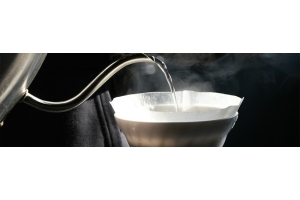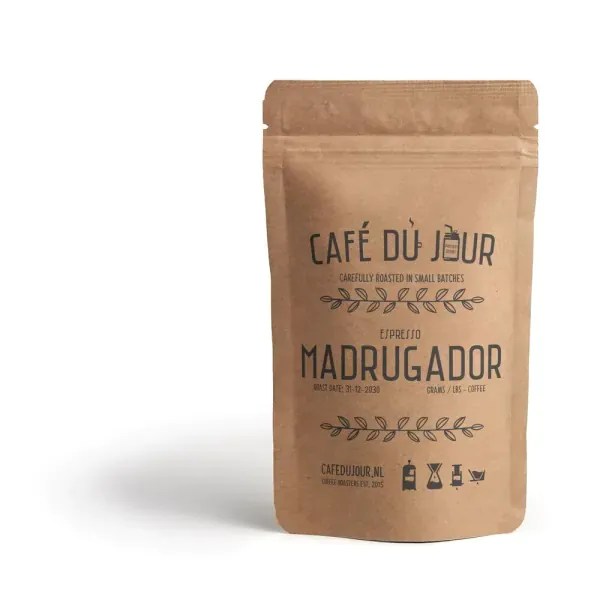Hoe zet je koffie? (11 zetmethoden)


Koffie zetten doe je door heet water in contact te brengen met gemalen koffie. Dit kun je op minstens elf verschillende manieren doen. Van een simpele filtermachine tot een stijlvolle Chemex of espressomachine. Welke methode je kiest, bepaalt de smaak, structuur en zelfs het aroma van je koffie.
Hier lees je hoe die verschillen precies ontstaan en helpen we je de zetmethode te vinden die het beste bij jouw smaak, ritme en koffiemoment past.
Wat is de beste manier om koffie te zetten?
De beste manier om koffie te zetten? Die bestaat niet. Althans, niet één die voor iedereen werkt. Wat voor jou de ideale kop koffie is, hangt af van jouw smaak, je ochtendroutine én hoeveel tijd je ervoor wilt nemen.
Hou je van een volle, krachtige smaak? Dan is een espressomachine of moka pot waarschijnlijk jouw ding. Wil je juist helder en verfijnd? Dan kom je uit bij slow coffee zoals de Chemex of V60. En als het vooral snel en makkelijk moet zijn, is een volautomaat of cupmachine jouw beste vriend.
Door verschillende methodes te proberen, merk je vanzelf wat bij jou past. Eén ding is zeker, met goede koffiebonen en een beetje aandacht kun je van bijna elke methode iets lekkers maken.
Koffie zetten met een machine
Zet jij graag koffie met één druk op de knop of juist met wat meer techniek? Dan is een koffiemachine jouw trouwe ochtendmaatje. Er zijn allerlei soorten machines, elk met hun eigen karakter: snel, krachtig, mild of vol aroma. Van volautomaat tot filterapparaat, voor elk type koffiedrinker is er wel een machine die past.
We nemen je mee langs de populairste koffiemachines en wat je ervan kunt verwachten. Zo ontdek je vanzelf welke bij jou (en je ochtendhumeur) past.
1. Espressomachine
Een espressomachine is dé favoriet van liefhebbers van intense koffie met een volle smaak. Het principe is simpel, maar briljant: heet water wordt met hoge druk door fijn gemalen koffie geperst. Het resultaat? Een kleine, intense shot met een dikke cremalaag, de bekende espresso.
Je hebt espressomachines in verschillende soorten en maten:
- Volautomatisch: zet koffie met één druk op de knop. Ideaal voor gemakzoekers.
- Halfautomatisch: iets meer werk, maar ook meer controle over smaak en techniek.
- Professioneel: volledig handmatig, voor de barista in hart en nieren.
Een goede espressomachine vraagt een beetje liefde (en onderhoud), maar geeft daar smaakvol iets voor terug. En ja, er komt soms wat oefening bij kijken, maar juist dat maakt het leuk voor de echte koffiefanaat.
Café du Jour tip: Gebruik versgemalen Café du Jour Espresso Madrugador, een licht fruitige espresso met een sterke kruidige, pittige kick.

1.1 Pistonmachine
Een pistonmachine, ook wel halfautomatische espressomachine genoemd, is voor de koffieliefhebber die het ambacht wil voelen. Hier doe je alles zelf: bonen malen, aandrukken (tampen), de juiste hoeveelheid water doorlaten én melk opschuimen als je een cappuccino maakt. Geen knopjes die alles voor je regelen, maar jij aan het roer.
Het resultaat? Een espresso of cappuccino van hoge kwaliteit, mits je de techniek een beetje onder de knie hebt. De smaak ligt vaak dichter bij die van een professioneel café dan bij een volautomaat.
Wat je nodig hebt:
- Een losse of ingebouwde bonenmaler
- Wat geduld en oefening
- Een liefde voor ritueel
Het kost meer tijd dan een volautomaat, en sommige modellen hebben maar één verwarmingsunit. Dat betekent: eerst koffie, dan melk, even wachten… Maar daar krijg je wel een prachtig kopje voor terug.
Café du Jour tip: Begin met een robuuste espressoboon als je gaat experimenteren. Onze Café du Jour Espresso Madrugador is hier ideaal voor, een licht fruitige espresso met een sterke kruidige, pittige kick.

1.2. Volautomatische koffiemachine
De volautomaat is jouw beste vriend als je snel, makkelijk en met zo min mogelijk gedoe koffie wilt zetten. Je vult het bonenreservoir, drukt op een knop en voilà: daar is je espresso, lungo of cappuccino. Alles gebeurt automatisch, van bonen malen tot melk opschuimen (bij sommige modellen).
Het grote voordeel van een volautomaat is het gemak. Zeker op drukke ochtenden is het fijn dat je binnen een halve minuut je kopje in handen hebt. De smaak is goed, consistent en afhankelijk van de kwaliteit van je machine zelfs verrassend rijk.
Hou er wel rekening mee dat de meeste volautomaten:
- minder krachtig zijn dan pistonmachines
- iets minder 'barista-vibe' geven
- regelmatig onderhoud nodig hebben (denk aan ontkalken en reinigen van het melkreservoir)
Café du Jour tip: Gebruik medium gebrande bonen voor het beste resultaat. Onze Café du Jour 100% arabica Mocca werkt bijvoorbeeld top in volautomaten en geeft een zachte, ronde smaak.

2. Filter-koffiezetapparaat
Een klassieker onder de koffiemachines: het filter-koffiezetapparaat. Misschien ken je 'm nog van vroeger, maar deze zetmethode is nog lang niet passé. Sterker nog, veel koffieliefhebbers keren juist terug naar deze eenvoudige manier van zetten. Waarom? Omdat het zorgt voor een grote hoeveelheid koffie met een zachte smaak.
Bij filterkoffie wordt heet water langzaam over gemalen koffie gegoten, die in een papieren filter ligt. Het water druppelt door de gemalen koffie heen en neemt zo de smaken op. Het resultaat is een heldere, milde koffie met aroma's die goed tot hun recht komen.
Ideaal voor:
- Gezellige koffiemomenten met visite
- Wie van een lichtere koffiesmaak houdt
- Mensen die 's ochtends in één keer een volle kan zetten
Café du Jour tip: Gebruik een medium gebrande koffie, zoals onze Café du Jour 100% arabica Zuid-Amerika, en een verse maling voor het lekkerste resultaat.

3. Koffiecupmachines
Koffiecupmachines, zoals Nespresso of Dolce Gusto, zijn razend populair, en dat is niet voor niets. Ze zijn compact, snel en zetten met één druk op de knop een redelijk goed kopje koffie. Geen gedoe met maling, hoeveelheid of timing. Je stopt een cup in het apparaat, drukt op start en binnen 30 seconden heb je koffie.
Voor veel mensen is dit dé methode voor gemak. Maar eerlijk is eerlijk: je levert wat in op versheid en complexiteit van smaak. De koffie in cups is namelijk vooraf gemalen en verpakt, en vaak minder vers dan losse bonen. Ook zijn cups prijzig én minder milieuvriendelijk, tenzij je herbruikbare capsules gebruikt.
Voordelen:
- Supersnel en handig
- Grote keuze aan smaken
- Compact formaat
Nadelen:
- Meer afval en hogere kosten per kop
- Minder intense en verse smaak
Café du Jour tip: Probeer hervulbare capsules die je vult met je eigen gemalen koffie. Zo combineer je gemak met de smaak van échte verse bonen.
Koffie zetten met de hand (slow coffee)
Voor wie van rust, ritueel en ambacht houdt, is slow coffee dé manier om koffie te zetten. Geen knoppen of machines, maar jijzelf die het tempo bepaalt. Deze handmatige zetmethodes vragen iets meer aandacht, maar geven daar veel voor terug: controle over smaak, extractie en aroma's.
Kies voor een Chemex, AeroPress of French press. Handmatig koffiezetten betekent vertragen. Je staat even stil bij je kopje en geniet van het proces net zo veel als van het resultaat.

4. Chemex
De Chemex is een elegante glazen karaf met een houten kraag en minstens zo stijlvol als functioneel. Deze methode draait om precisie: je giet langzaam heet water over versgemalen koffie in een dik papieren filter. Het resultaat? Een heldere, zachte koffie met een lichte body en verfijnde aroma's.
Wat deze methode bijzonder maakt, is het dikke filterpapier. Dat houdt oliën en fijne koffiedeeltjes tegen, waardoor je koffie schoon en fris smaakt. Ideaal voor wie houdt van subtiele, florale tonen of een lichte roast.
Typisch Chemex:
- Tijd: ± 4 minuten
- Maalgraad: medium tot grof
- Moeilijkheid: gemiddeld (je hebt een schenktuit nodig en wat oefening)
Café du Jour tip: Gebruik een waterkoker met temperatuurregeling en kies een lichte of medium roast. Probeer bijvoorbeeld onze Café du Jour 100% arabica Costa Rica. Deze is fruitig, zacht en perfect voor de Chemex.

5. V60 & Kalita Wave
De V60 en Kalita Wave zijn twee populaire pour-over methodes, oftewel: handmatig overgieten. Beide gebruiken een filterhouder en papieren filters, maar verschillen in vorm en doorstroomsnelheid. De V60 heeft een enkele, grote opening in de punt, terwijl de Kalita meerdere kleine gaatjes gebruikt voor een stabielere doorloop.
Met deze methodes heb je veel controle over de smaak. Door zelf het water langzaam op te gieten in cirkelbewegingen, bepaal je hoeveel extractie er plaatsvindt. De koffie smaakt helder, gebalanceerd en heeft vaak een wat fruitige, frisse ondertoon.
Typisch pour-over:
- Tijd: ± 3–4 minuten
- Maalgraad: medium
- Moeilijkheid: gemiddeld (schenktechniek vereist wat oefening)
Café du Jour tip: Gebruik een koffie met een uitgesproken aroma, zoals onze Café du Jour Specialiteit 100% arabica Yirgacheffe. Giet deze langzaam in een spiraal. Rust is hier je geheime ingrediënt.

6. AeroPress
De AeroPress ziet eruit als een kruising tussen een grote spuit en een laboratoriuminstrument, maar schijn bedriegt: dit compacte apparaatje zet verrassend lekkere koffie. Je mengt heet water met gemalen koffie, laat het kort trekken, en duwt het geheel met lichte druk door een filter.
Het resultaat is een heldere, rijke kop koffie met weinig bitterheid en veel smaak. En dat allemaal binnen twee minuten. Ideaal voor thuis, op kantoor of onderweg, de AeroPress is licht, stevig en makkelijk schoon te maken.
Waarom je 'm wilt proberen:
- Tijd: ± 2 minuten
Maalgraad: medium tot fijn - Moeilijkheid: laag tot gemiddeld
- Resultaat: zachte, volle koffie
Café du Jour tip: Varieer met de trektijd en druk. Een korte extractie geeft een lichtere kop, een langere juist meer body. Probeer eens onze Café du Jour 100% arabica Cerrado, lekker nootachtig en romig in de AeroPress.

7. Siphon
De siphon, ook wel vacuümpot genoemd, is een koffiemethode waarbij wetenschap en theater samenkomen. Het apparaat bestaat uit twee glazen bollen, een filter en een warmtelampje of gasbrander. Het ziet eruit alsof je in een scheikundelokaal bent beland, maar het resultaat is puur koffiegenot.
Door verhitting stijgt het water naar de bovenste kamer, waar het mengt met de koffie. Als de hittebron verdwijnt, zakt het mengsel weer naar beneden door het filter. Dit proces zorgt voor een volle, gelaagde smaak die je met geen enkele andere methode zo exact krijgt.
Wat je moet weten:
- Tijd: ± 6–8 minuten
- Maalgraad: medium
- Moeilijkheid: hoog (precisie vereist)
- Resultaat: volle, heldere en complexe koffie
Café du Jour tip: Gebruik een koffie met veel smaaklagen, zoals onze Café du Jour 100% arabica Nicaragua. Laat je niet afschrikken door het uiterlijk, want deze methode is een ware beleving voor de liefhebber.

8. French press (Cafetière)
De French press is misschien wel de meest relaxte manier van koffiezetten. Geen filters, geen ingewikkeld gedoe, gewoon grof gemalen koffie, heet water en een paar minuten geduld. Na zo'n vier minuten druk je het metalen filter langzaam naar beneden en voilà: een volle, olieachtige kop koffie met karakter.
Deze zetmethode laat de natuurlijke oliën en microdeeltjes in je koffie zitten, wat zorgt voor een rijke textuur en krachtige smaak. Ideaal voor wie houdt van een robuuste bak, zonder dat het bitter wordt.
Waarom de French press zo fijn is:
- Tijd: ± 4 minuten
- Maalgraad: grof
- Moeilijkheid: laag
- Resultaat: volle, ronde koffie
Lees hier meer over het zetten van koffie met een French Press.
Café du Jour tip: Gebruik een koffie met een stevige body, zoals onze Café du Jour 100% arabica Zuid-Amerika. En roer je koffie even door na het inschenken, dat maakt 'm nóg lekkerder.

9. Cold Brew
Cold brew is de ideale zetmethode voor warme dagen of koffiedrinkers die houden van een zachte, cafeïnerijke kick. In plaats van heet water gebruik je koud water, en dat laat je 12 tot 24 uur trekken met grof gemalen koffie. Het resultaat is een mild, soepel brouwsel zonder bitterheid – perfect om over ijs te schenken.
Doordat de koffie langzaam en koud extraheert, krijg je een totaal andere smaak dan bij warme bereidingen: weinig zuren, veel zoetheid en een extra geconcentreerde body.
Zo werkt cold brew:
- Tijd: 12–24 uur
- Maalgraad: grof
- Moeilijkheid: laag
- Resultaat: zacht, fris en krachtig
Café du Jour tip: Gebruik een chocoladetoon-rijke boon zoals onze Café du Jour 100% arabica Colombia. En serveer je cold brew met een schijfje sinaasappel of een scheutje havermelk voor een verfrissende twist.
Koffie zetten op het vuur
Geen stroom? Geen probleem. Ook met enkel een fornuis, gaspitje of kampvuur kun je een heerlijk sterke kop koffie zetten. Zetmethodes op het vuur zijn vaak compact, betaalbaar en geliefd om hun karakteristieke, volle smaak. Denk aan de klassieke moka pot of de traditionele Turkse Ibrik.

10. Moka pot (Percolator)
De moka pot, ook wel percolator genoemd, is een Italiaanse klassieker die je op het fornuis gebruikt. In de onderste kamer kookt het water, waardoor de druk het water omhoog stuwt, door de gemalen koffie in het middenreservoir. Uiteindelijk belandt de koffie in het bovenste compartiment, klaar om in te schenken.
De smaak lijkt op espresso: krachtig, intens en met een licht bittertje. Ideaal voor wie van een stevige bak houdt maar geen espressomachine heeft (of wil). En bonus: je kunt meerdere kopjes tegelijk zetten.
Wat je kunt verwachten:
- Tijd: ± 5 minuten
- Maalgraad: fijn (maar niet té)
- Moeilijkheid: gemiddeld (even oefenen met timing)
- Resultaat: sterk, aromatisch, beetje stroperig
Lees hier meer over welke koffie je in een percolator gebruikt.
Café du Jour tip: Onze Café du Jour Espresso Intenso werkt uitstekend in mokapots: vol, rijk en met die typische Italiaanse punch.

11. Ibrik (Turkse koffie)
Turkse koffie, gezet in een ibrik of cezve, is misschien wel de meest traditionele en ceremoniële manier om koffie te bereiden. Je gebruikt zeer fijn gemalen koffie (poederachtig), koud water en eventueel suiker. Alles gaat samen in een klein koperen of messing pannetje, en dan verwarm je het langzaam op laag vuur.
De koffie mag niet koken. Zodra het schuim omhoog komt, haal je de ibrik van het vuur, laat het schuim zakken en verwarm je het eventueel nog een keer. Het resultaat is een intens, dik en aromatisch kopje koffie dat je mét koffiedik serveert – en dus langzaam drinkt.
Typisch aan de ibrik-methode:
- Tijd: ± 5–6 minuten
- Maalgraad: ultra fijn
- Moeilijkheid: gemiddeld (beheersing van hitte is key)
- Resultaat: vol, kruidig en romig
Café du Jour tip: Voeg een snufje kardemom toe voor de authentieke Turkse smaak. Onze Café du Jour 100% arabica Brazilië is hier perfect voor – diep, rijk en traditioneel.
Wat is de goedkoopste manier om koffie te zetten?
Wil je goede koffie drinken zonder veel uit te geven aan apparaten? Dan zijn er genoeg opties die vriendelijk zijn voor je portemonnee. De goedkoopste manier is cold brew, je hebt alleen koffie, water en tijd nodig. Maar als je liever warme koffie zet, zijn er ook betaalbare keuzes.
Dit zijn onze budgetvriendelijke favorieten:
- French press: betaalbaar, makkelijk in gebruik en je hebt geen filters nodig.
- Moka pot: stevig en duurzaam, zet espresso-achtige koffie op het fornuis.
- Pour over (V60 of Kalita): goedkoop op te starten, wel met papieren filters.
- AeroPress: compact, betaalbaar en ideaal voor één persoon.
Let op: bij vrijwel alle handmatige methoden is een goede koffiemolen een slimme investering. Versgemalen koffie maakt écht het verschil. En je hoeft niet meteen een dure elektrische molen te kopen, want er zijn ook handmolens beschikbaar.
Alle koffiezetmethodes met elkaar vergeleken
Er zijn flink wat manieren om koffie te zetten – en allemaal hebben ze hun eigen smaak, tempo en karakter. Om het je makkelijk te maken, hebben we de belangrijkste zetmethodes voor je op een rij gezet. Zo zie je in één oogopslag wat bij jou (en je koffiemoment) past.
| Zetmethode | Tijd | Moeilijkheid | Maalgraad | Resultaat | Smaakprofiel |
|---|---|---|---|---|---|
| Espressomachine | Snel | Hoog | Zeer fijn | Intense espresso | Vol, krachtig |
| Pistonmachine | Snel | Hoog | Zeer fijn | Barista-waardige espresso | Complex, vol |
| Volautomaat | Zeer snel | Laag | Medium tot fijn | Goede standaard espresso | Ronder, zachter |
| Filterapparaat | Gemiddeld | Laag | Medium | Grote hoeveelheid, mild | Aromatisch, helder |
| Koffiecupmachine | Zeer snel | Zeer laag | Voorverpakt | Snelle kop met constante smaak | Medium, vlakker |
| Chemex | Langzaam | Gemiddeld | Medium-grof | Schone, heldere koffie | Elegant, licht |
| V60 / Kalita | Gemiddeld | Gemiddeld | Medium | Gebalanceerde slow coffee | Frisser, fruitiger |
| AeroPress | Snel | Gemiddeld | Medium | Zachte, pure koffie | Rijk, mild |
| Siphon | Langzaam | Hoog | Medium | Theater en smaak in één | Vol, complex |
| French press | Snel | Laag | Grof | Volle koffie met textuur | Rijk, aards |
| Cold brew | Zeer lang | Laag | Grof | Ijskoffie met veel body | Zacht, cafeïnerijk |
| Moka pot | Gemiddeld | Gemiddeld | Fijn | Sterk, intens brouwsel | Bitterzoet, stevig |
| Ibrik (Turks) | Gemiddeld | Gemiddeld | Poederfijn | Dikke, aromatische koffie | Rijk, kruidig |















